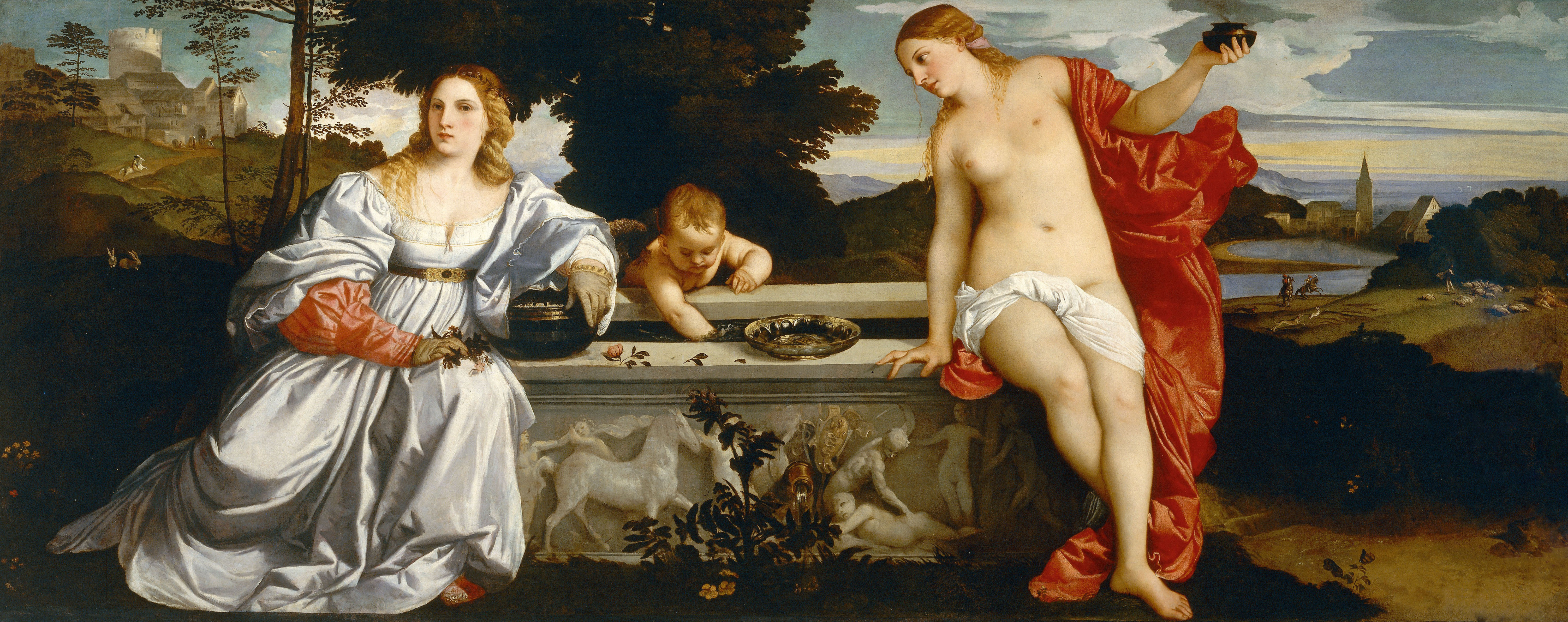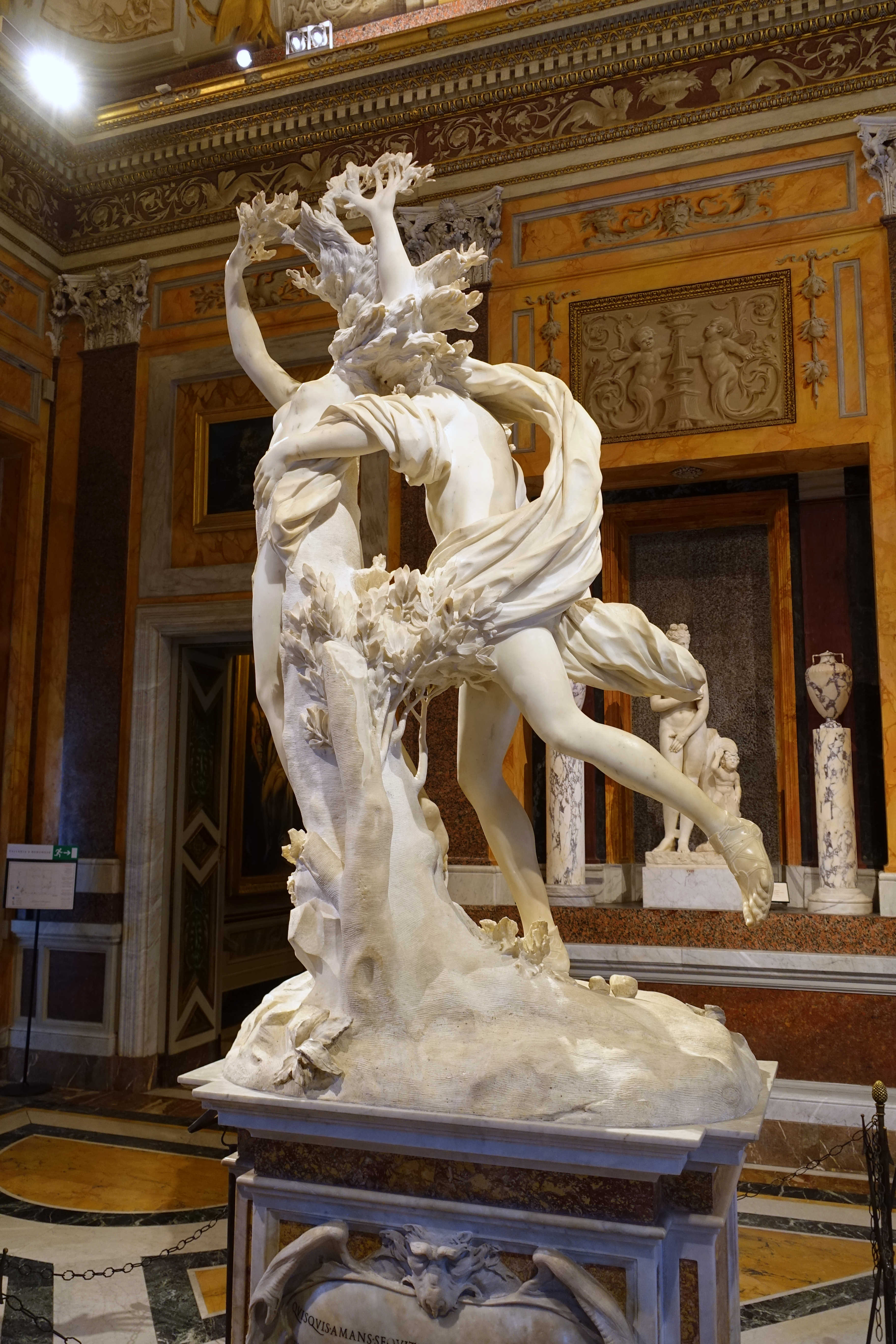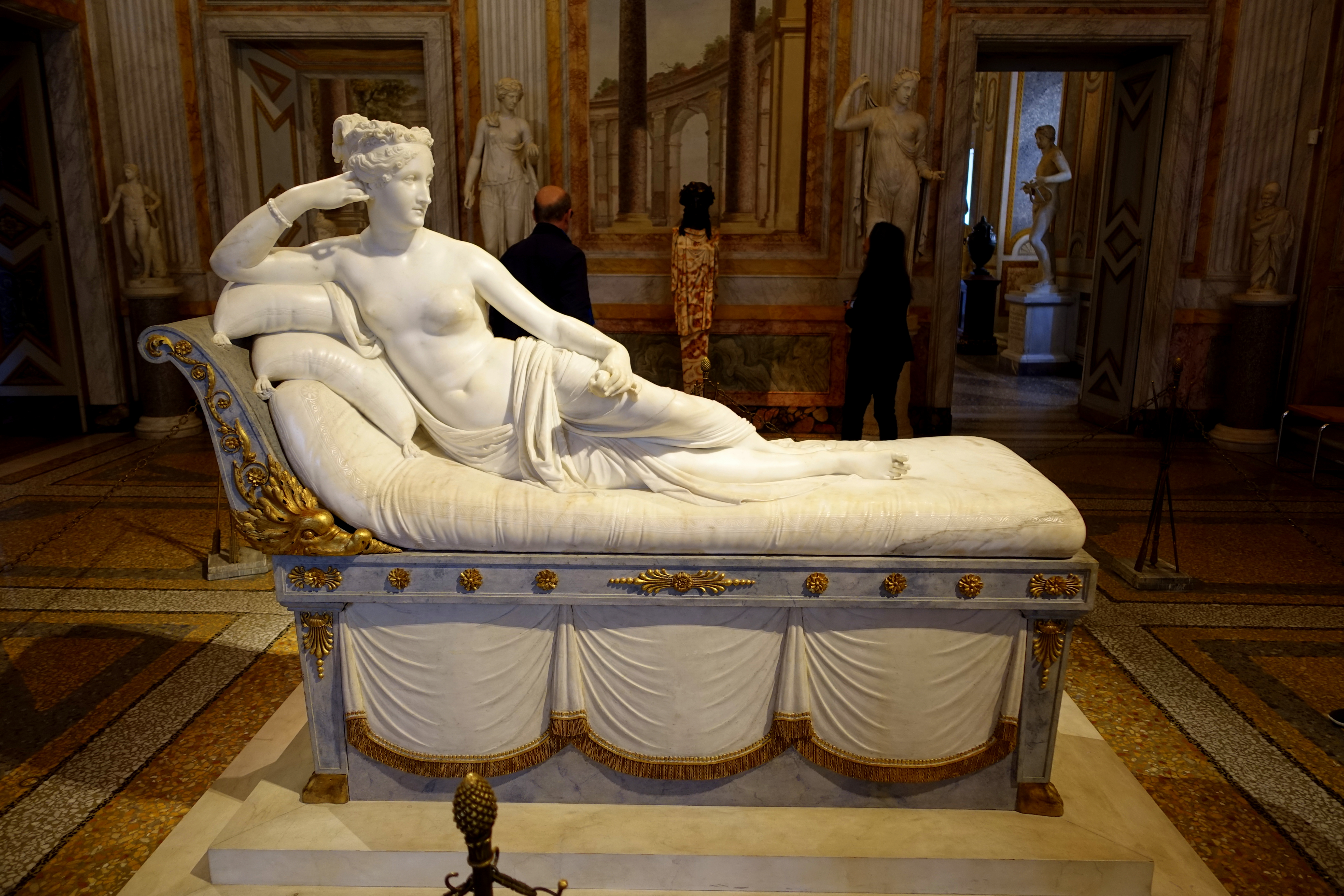The Borghese Gallery is home to some of the most precious and culturally significant pieces of art in the world. You should take time to explore the entire collection, as there is something for everyone to appreciate. Our page provides a full list of the most important things to see at the Borghese Gallery, so you can get the most out of their experience. It includes highlights such as the Apollo and Daphne sculpture and Caravaggio’s David with the Head of Goliath. Additionally, the Gallery houses several sculptures by Gian Lorenzo Bernini, as well as works from other renowned artists such as Raphael and Titian.
Ultimate Guide to Villa Borghese
Paintings to see in the Borghese Gallery
San Domenico (Titian)
Saint Dominic was a Castilian priest and founder of the Dominican Order who is believed to have been immortalized by the renowned Venetian painter Titian. While Titian is estimated to have created around 400 works of art in his lifetime, only roughly 300 survive today, displayed in galleries, museums, and private collections throughout the world.
Sacred and Profane Love (Titian)
Sacred and Profane Love (Italian: Amor Sacro e Amor Profano) is an oil painting by renowned artist Titian, which is estimated to have been created around 1514. It is believed to have been commissioned by Niccolò Aurelio, a secretary to the Venetian Council of Ten, whose coat of arms is visible in the painting’s sarcophagus or fountain. It is thought to be a representation of the bride, dressed in white, accompanied by Cupid and the goddess Venus, in honor of Aurelio’s marriage to Laura Bagarotto. The title of the painting, which was first mentioned in an inventory in 1693 as Amor Divino e Amor Profano (Divine Love and Profane Love), may not be reflective of the original concept. Art historians have long studied the painting’s iconography in an attempt to uncover its true meaning, yet some of its main points remain unresolved.
Aeneas Fleeing from Troy (Federico Barocci)
Federico Barocci’s painting, ‘Aeneas Fleeing from Troy’, is a remarkable artwork that has been preserved in the Borghese Collection in Rome. Measuring 176 x 253 cm, it is Barocci’s only attempt at historical narration. Originally commissioned as a gift for the Emperor of the Holy Roman Empire, Rudolph II, by the Della Rovere family, the piece was later adapted for Cardinal Scipione Borghese and had its allegory altered to reflect spiritual purity.
What is particularly interesting about this painting is how Barocci has managed to incorporate the desires of his patrons into his work. It was long assumed that the two versions of Aeneas were identical, however, a large-scale cartoon with a distinctively different landscape than in the surviving painting suggests that Barocci interpreted the first version differently. This raises interesting questions about patronage and the exchange of gifts, and how the artist was able to employ his skills and replication process to great effect.
The Deposition (Rubens)
The Deposition of Christ by Peter Paul Rubens is a renowned painting created in 1602 which was previously attributed to Van Dyck. During his first stay in Rome, Rubens was commissioned to create three works for the chapel of Sant’Elena in the church of Santa Croce in Gerusalemme in 1601-1602 and the altarpiece for the church of Chiesa Nuova (Santa Maria in Vallicella) in 1606-1608. As a result, he left a memorable mark on painting in Rome in the first decade of the 17th century, being influenced by the works of Titian.
The painting entered the Borghese Gallery much later and was first recorded in the fideicommissum of 1833, attributed to Anthony van Dyck. In the foreground, the body of Christ is laid to rest on a tomb which imitates an ancient sarcophagus with bas-reliefs. The funeral genius weeping on the altar and the element of sacrifice are illustrated on one of the short sides, while the crown of thorns and nails on the grave are symbolic of the sacrifice of the Son of God.
This painting serves as a testament to the genius of Peter Paul Rubens and the lasting impact he had on Roman painting in the early 17th century.
Susanna and the Elders (Rubens)
Susanna and the Elders is a painting created by Flemish artist Peter Paul Rubens in 1607. This artwork, which measures 94 x 65 cm, can be found in Room XVIII of the Borghese Gallery. The painting is based on the story of Susanna in the deuterocanonical chapter of the biblical Book of Daniel. In the 16th century, the Venetians and Carracci School often used this story as a chance to portray female nudity, and this was the first painting Rubens made on the subject.
Rubens produced the painting while in Rome in 1601-1602 and it was added to the collection of the Borghese Gallery before his other works in the room.
The painting captures the moment when Susanna, a young married Jewish woman living in Babylon during the first exile of the Jewish people, is illuminated from the right and twists her body towards the elders who have suddenly appeared behind her. Susanna is draped in a white cloth which symbolizes her purity and goodness as she has not committed adultery; however, her face reflects shock and fear at the elders’ presence. Ultimately, thanks to Daniel’s intervention, she is spared from being stoned to death.
Tobias and the Angel (Savoldo)
Giovanni Girolamo Savoldo’s oil on canvas painting, “Tobias and the Angel,” is a work of art that resides in the Galleria Borghese in Rome since 1910.
The painting portrays the moment in which the archangel Raphael informs Tobias of the need to capture a fish to cure his father’s blindness. Savoldo paid particular attention to the details of the drapery, as it appears to have a silvery sheen, and to the naturalistic elements in the painting, such as the light that penetrates the foliage and the atmospheric clouds in the distance. Although the angel’s features resemble those of the one in Titian’s Averoldi Polyptych, painted a few years prior, the sentimentality of the painting is more in line with Giorgione’s pastoral tones.
The artist also focused on the realism of Tobias’ character, as he is depicted as a young man full of energy. Additionally, the scene is unique in that it portrays Tobias and the Angel in a pause, rather than in the common tradition of them walking. This painting showcases Savoldo’s skill as a painter and his ability to capture the emotion of the moment.
Leda and the Swan (Galleria Borghese)
Leda and the Swan is a painting from the circle of Leonardo da Vinci, with Cesare da Sesto being the most likely artist. It was created when Leonardo was exploring the theme of Leda during his work on the Mona Lisa. This painting was described by Cassiano del Pozzo in 1625, yet the work had disappeared by the 18th century. Fortunately, there have been a few remnants left to give an idea of what the original may have looked like. These remnants include drawings of Leonardo’s head, a bust of Leda, a drawing in red chalk, a Bugiardini picture, a copy by Francesco Melzi and a copy by Cesare da Sesto. Of these, the copy by Cesare da Sesto is said to be the closest to the original Leonardo and is currently on display at the Galleria Borghese.
Danaë (Correggio)
Danaë, a painting by the Italian Renaissance artist Correggio, was commissioned by the Duke of Mantua Federico II Gonzaga as part of a series depicting Jupiter’s loves. After Federico’s death, the painting was relocated to Spain, then Milan, and eventually to Prague, Stockholm, and Rome. In 1792 it was sold to England and owned by the Duke of Bridgewater and Henry Hope. In 1827, it was acquired in Paris by Prince Camillo Borghese for his Roman collection.
The painting depicts the Greek mythological figure Danaë, the daughter of Acrisius, king of Argos. As told by the Roman poet Ovid in his Metamorphoses, Jupiter reached Danaë in the form of a golden rain and made her mother to Perseus. In Correggio’s painting, Danaë is seen lying on a bed while a child Eros undresses her as gold rains from a cloud. At the foot of the bed, two putti are testing gold and lead arrows against a stone.
The Deposition (Raphael)
Raphael’s Deposition is considered one of the artist’s earliest masterpieces. It was painted prior to his move to Rome and many other well-known works such as the Madonna of the Chair and the Fornarina. The painting is connected to a tragic episode that occurred in Perugia in the early 16th century. It depicts the moment in which the body of Christ is being moved to the sepulcher and the three men carrying it are arched due to their effort. All around, women are in agony and despair. In the center of the painting is the dead Grifonetto Baglioni, the painting’s dedicatee. Saint John is the figure with folded hands looking at the body of Christ.
Raphael’s landscape is a beautiful homage to Leonardo da Vinci’s works, with Mount Calvary visible in the background. In the distance, the landscape is characterized by Leonardo’s sfumato, while the rest of the painting is brought to life by bright colors, making it one of Raphael’s masterpieces. The painting is signed and dated “RAPHAEL URBINAS MDVII” and required a great deal of preparatory work and sketches.
The painting was originally placed in the same Church in which Raphael’s Oddi Altarpiece hangs. The Deposition’s success made the artist even more famous and caused a turning point in his life, leading to his invitation to Rome by Pope Julius II.
Young Woman with Unicorn (Raphael)
Portrait of Young Woman with Unicorn is a masterpiece of the Renaissance, painted by one of its most renowned artists, Raphael. This painting, which is dated to have been painted between 1505 and 1506, is currently located at the Galleria Borghese in Rome. In 1934, the painting was transferred to canvas and underwent conservation, during which time overpainting was removed, revealing a unicorn, as well as removing a wheel, cloak and palm frond that had been added in the mid-17th century.
The painting is believed to have been inspired by Leonardo Da Vinci’s Mona Lisa, with the three-quarter length format and the sitter placed in a loggia opening out onto a landscape. The painting was originally attributed to Perugino, until it was realized that it was in fact by Raphael. This was confirmed in the 1930s restoration, which also revealed the unicorn, a symbol of chastity in medieval romance. Further restoration in 1959 revealed an image of a small dog, a symbol of conjugal fidelity, which was underneath the unicorn. This served as the sketch for the final look of the unicorn.
Young Sick Bacchus (Caravaggio)
The Young Sick Bacchus, also known as the Sick Bacchus or the Self-Portrait as Bacchus, is an early self-portrait by Italian Baroque artist Michelangelo Merisi da Caravaggio. It is believed to have been painted between 1593 and 1594, shortly after Caravaggio’s arrival to Rome. Recent studies have suggested that Caravaggio may have suffered from malaria, indicated by the painting’s jaundiced skin and icterus in the eyes. Another diagnosis that has been suggested is Addison’s disease, based on the signs of anemia and acanthosis nigricans.
The painting is also thought to have been used by Caravaggio to demonstrate his skills in painting genres such as still-life and portraiture, as well as his ability to depict classical figures of antiquity. It is believed that the grimace and tilt of the head as well as the sense of suffering depicted in the painting is a representation of the artist’s physical and mental condition at the time. This can be compared with later works such as the Boy With a Basket of Fruit and the Boy Bitten by a Lizard, which show a much improved condition.
David with the Head of Goliath (Caravaggio)
In May 1606, Caravaggio was accused of murder and fled Rome in order to avoid the price that had been put on his head. In a desperate attempt to receive a pardon, he painted a self-portrait as Goliath’s severed head, held by David his executioner, and sent it to the papal court in 1610. Although he was eventually pardoned, the pardon did not arrive before Caravaggio’s death in Porto Ercole.
David with the Head of Goliath is a remarkable tribute to the painting style of Titian, with David’s face encircled by a shining halo. Unlike Michelangelo’s David, Caravaggio’s David holds a sword in one hand and a set of scales in the other, indicating his role as a judge. This relates to Christ, who is both the ultimate judge and savior. In contrast to David’s youthful vigor, Caravaggio paints himself as Goliath in a somber, despairing manner. His forehead is bruised and his eyes are unfocused and lifeless. The juxtaposition of life and death in this painting is symbolic of not only the body, but also of the soul. Caravaggio’s representation of himself as damned is a powerful reflection of his criminal past and sexual improprieties.
Saint Jerome Writing (Caravaggio)
Caravaggio’s Saint Jerome Writing is a painting that reflects the artist’s mastery of chiaroscuro and his deep understanding of the human condition. The painting is located in the Galleria Borghese in Rome and is believed to be dated from 1605 to 1606. The painting depicts Saint Jerome, a popular subject for Caravaggio, who is shown intently reading with an outstretched arm and quill. It has been suggested that Jerome is in the act of translating the Vulgate. The painting was requested by Cardinal Scipione Borghese but it is possible he acquired it later. It is believed to be from Caravaggio’s late Roman period which ended with his exile to Malta in 1606. St Jerome Writing has been questioned as to its authenticity due to its attribution to Jusepe de Ribera in the Borghese inventories from 1700 until 1893.
Boy with a Basket of Fruit (Caravaggio)
Caravaggio’s Boy With a Basket of Fruit dates back to the early 1600s, when the artist had just arrived in Rome from Milan. The painting features his friend, the Sicilian painter Mario Minniti, at around 16 years of age. The piece was originally held in Giuseppe Cesari’s collection and was seized by Cardinal Scipione Borghese in 1607. It is believed to be from the period when Caravaggio worked for Cesari producing flower and fruit paintings, or possibly after he and Minniti had left Cesari’s workshop in January 1594.
The painting is a fine example of Caravaggio’s realism; the artist captures only what is in the basket without idealizing either their ripeness or arrangement. However, it is still an aesthetically pleasing piece, as it draws the viewer in with its beauty and elegance. Vittorio Sgarbi has noted certain Murilleque portraiture qualities in the painting that could suggest the influence of Cesari’s workshop.
Melissa (Dossi)
Dosso Dossi’s painting, entitled Circe (or Melissa), is an oil on canvas work dated to c.1518. The artist, Giovanni de Lutero, was an Italian painter of the late Renaissance period, influenced by Giorgione and Raphael and having studied in the workshop of Lorenzo Costa. Dossi was renowned for his captivating landscapes, a rarity for the time, which are often dominant in his works, such as with Melissa. The painting was sent from Ferrara to Scipione Borghese by Cardinal Enzo Bentivoglio and was first mentioned in Giacomo Manilli’s collection in 1650. Recent conservation work has revealed the presence of various “pentimenti” on the left side.
The painting depicts a female figure with a turban and a mantle of vibrant colors, holding a torch and a tablet with cabbalistic designs. She has been identified as both Homer’s Circe and Melissa, based on Ludovico Ariosto’s poem, “Orlando Furioso” (canto VIII, 14-15), which describes the liberation of a group of knights represented in the painting by the embryonic forms hanging on the tree trunks on the left. Thus, the painting is a powerful portrayal of the mythological and literary characters and of the artistic ability of Dosso Dossi.
Sculptures to see in the Borghese Gallery
Bust of Pope Paul V (Bernini)
Gian Lorenzo Bernini, a renowned Italian artist, created two Busts of Pope Paul V, one of which is currently housed in the Galleria Borghese in Rome and is believed to be from 1618. In 2015, a second bust, commissioned by Cardinal Scipione Borghese, was acquired by the J. Paul Getty Museum in Los Angeles. This bust was crafted by Bernini in 1621, shortly after the death of Pope Paul V. Additionally, a bronze version of this sculpture is located in the Statens Museum for Kunst in Copenhagen, Denmark.
The Goat Amalthea with the Infant Jupiter and a Faun (Bernini)
The Goat Amalthea with the Infant Jupiter and a Faun is Gian Lorenzo Bernini’s earliest known work and was produced somewhere between 1609 and 1615. According to Filippo Baldinucci, the artist created a “small marble head of a child that amazed everyone” when he was just eight years old. As a teenager, Bernini created numerous images of putti which were chubby male children, usually nude and sometimes winged. These figures differed from cherubim which were religious and represented the second order of angels. Out of the three marble groups of putti that can be attributed to Bernini, The Goat Amalthea with the Infant Jupiter and a Faun is the only one that is approximately dateable. In 1615, a carpenter was paid for providing a wooden pedestal for the sculpture group. This has led to some writers proposing a date of 1609, based on stylistic grounds and the 1615 pedestal invoice which could be interpreted as a replacement.

The Goat Amalthea with the Infant Jupiter and a Faun (Bernini)
Aeneas, Anchises, and Ascanius (Bernini)
Gian Lorenzo Bernini’s sculpture of Aeneas, Anchises and Ascanius, located in the Galleria Borghese, is a beautiful homage to the second book of Vergil’s Aeneid. This life-size sculpture was created when Bernini was only twenty years old, and it was originally thought to be the work of his father, Pietro. Even now, many still debate whether Bernini had help from his father or not.
The sculpture depicts a scene from the Aeneid, in which Aeneas is seen escorting his father Anchises and son Ascanius away from Troy. Aeneas is carrying his father on his shoulders, and Anchises is holding two small statues, the penates. The details of the sculpture are incredible, and it serves as a testament to the skill of Gian Lorenzo Bernini at such a young age.
The Rape of Proserpina (Bernini)
Gian Lorenzo Bernini’s Rape of Proserpina (Ratto di Proserpina) is a Baroque-style sculptural group comprised of marble, commissioned by Cardinal Scipione Borghese and completed between 1621 and 1622 when Bernini was only twenty-three years old. This artwork depicts the abduction of Proserpina by Pluto, the god of the underworld. Cardinal Scipione paid Bernini 450 Roman scudi for the sculpture, and it was later given to Cardinal Ludovisi in 1622 before being re-acquired by the Italian state and returned to the Villa Borghese in 1908.
The myth of Proserpina’s abduction is based on Roman mythology. Proserpina is the daughter of Ceres, the goddess of fertility, and Jupiter, the patron sky and thunder god. While Proserpina was out picking flowers with her friends, the ruler of the underworld, Pluto, saw her and fell in love. He snatched her away in a chariot pulled by four black horses and took her to the underworld. When Ceres heard her daughter’s cries for help, she searched for her and became so angry that she cursed the land and caused a great famine. Realizing the catastrophe that had occurred, Jupiter intervened and struck a deal that Proserpina would spend half a year with her mother and the other half in the underworld with Pluto.
David (Bernini)
David is a life-size marble sculpture created by Gian Lorenzo Bernini and commissioned by Cardinal Scipione Borghese for his villa. It was completed in the span of seven months in 1623-1624. The artwork depicts the biblical David, poised to throw the stone that will bring down Goliath and grant him the ability to behead him. This sculpture is considered to be an innovative piece, due to its implied movement and psychologically intense nature, compared to other works on the same subject.
Prior to working on the David, Bernini had been commissioned to do various sculptural works for the villa of his patron, Cardinal Scipione Borghese. He was working on the sculpture of Apollo and Daphne when he abruptly shifted his focus to David. Records indicate that Bernini had begun work on the sculpture by mid-1623, and was finished by the same time the following year.
Apollo and Daphne (Bernini)
Gian Lorenzo Bernini’s Apollo and Daphne, unveiled in 1625, is a masterpiece of Baroque sculpture. At the time, the work was celebrated as a ‘meraviglia’, or marvel, due to its incredible level of artistry and skill. Despite being just 30 years old, Bernini had managed to capture a multitude of emotions within the piece; from the fear of the woman being chased, to the desire of the man who won’t accept no as an answer.
Four centuries later, Apollo and Daphne still captivates viewers with its stunning beauty and its darkly relevant themes of sexual aggression and power imbalance. Bernini’s feat of carving motion and transformation from stone has rarely been matched, and the piece continues to be one of his most acclaimed works.
Truth Unveiled by Time (Bernini)
Gian Lorenzo Bernini’s sculpture Truth Unveiled by Time is a masterpiece of artistry, created to express a retort to his opponents’ criticisms of his failed architectural project. The sculpture depicts a naked young woman being unveiled by a figure of Time, a figure which unfortunately was never completed. Although the figure of Time was left unfinished, Bernini’s attention to detail was still visible in his work, which was completed in 1652 and left to the first-born of the Bernini family in his will.
Although Bernini tried to sell the sculpture to Cardinal Mazarin of France, it remained in his family until 1924 when it was purchased by the Italian government and transferred to the Galleria Borghese. The sculpture’s plinth had been tilted down but was recently restored to a flat surface, leaving Truth in an upright position as it would have originally been displayed.
The sculpture is a reminder of Bernini’s skill, even in the face of the controversy surrounding his failed project. A reminder that truth can be unveiled by time, and history will always remember the artist’s work.
Venus Victrix (Canova)
The Portrait of Paolina Borghese, commissioned by Prince Camillo Borghese in 1804, is one of the iconic masterpieces of the Galleria, completed by Antonio Canova in 1808. The pair had married in Paris just a year prior, with Napoleon’s blessing as the beautiful and vivacious Pauline Bonaparte was his beloved sister. Upon returning to Rome, Pauline’s lifestyle of display and amusements was able to resume.
Though many rumors swirled regarding the creation of the portrait, with Pauline herself allegedly making the comment, “all veils may fall before Canova”, it is actually an ideal portrait, displaying the princess as Venus and the victor of the judgment of Paris, as indicated by the apple she is holding. This work is a summation of Canova’s figurative culture, paying homage to both classical and Venetian traditions of painting.
The rendering of the mattress beneath the goddess is awe-inspiring, and is reminiscent of another illustrious precedent – the mattress that Bernini sculpted for his Hermaphrodite which had belonged to Scipione Borghese. The original mechanism which enables the sculpture to rotate 360 degrees is still functional, further adding to the realistic quality of the work.
In conclusion, the Portrait of Paolina Borghese stands as an icon of Canova’s singular Neoclassicism, and a reminder of the great care taken in its creation.








